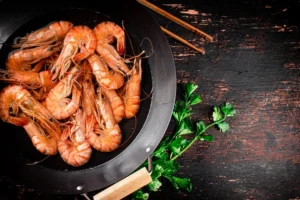5% off your first order of $30+. Get Promo Code

Curious about the world of snail cuisine? You’re not alone. This often-overlooked delicacy is a staple in various cultures, offering not just unique flavors but also a host of nutritional benefits. From the spicy snail stews of Nigeria to the garlic-infused escargot of France, snails are more than just garden critters; they’re a culinary experience waiting to be explored. In this comprehensive guide, we’ll delve into the art of preparing and savoring snail dishes, offering insights into cooking techniques, cultural variations, and even where to source this intriguing ingredient. Whether you’re a seasoned foodie or a curious beginner, prepare to expand your culinary horizons.
Types of Snail Dishes
Nigerian:
- Snail pepper soup: This is a famous Nigerian soup made with snails, assorted meats, and vegetables. It is typically served with pounded yam or fufu.
- Snail stew: This is a thick stew made with snails, tomatoes, onions, and spices. It is typically served with rice or plantains.
- Snail moi-moi: This steamed bean pudding is made with snails, beans, and spices. It is typically served with a tomato-based sauce.
Intercontinental:
- French escargot: This is a classic French dish with snails cooked in garlic butter. It is typically served in a shell and topped with cheese.
- Spanish caracoles a la llauna: This is a Spanish dish made with snails that have been cooked in a tomato sauce. It is typically served with bread.
- Italian lumache al sugo: This is an Italian dish made with snails that have been cooked in a tomato sauce. It is typically served with pasta.
- Greek chili snails: This is a Greek dish made with snails that have been cooked in a chili sauce. It is typically served with rice or pita bread.
- Moroccan snails: This is a Moroccan dish made with snails that have been cooked in a cumin-flavored sauce. It is typically served with bread.
Other:
- Snail curry: This is a curry dish made with snails, vegetables, and spices. It is typically served with rice or naan.
- Snail stir-fry: This is a stir-fry dish made with snails, vegetables, and spices. It is typically served with rice or noodles.
- Snail tacos: This is a Mexican dish made with snails that have been cooked in a chili sauce and served in tortillas.
- Snail pizza: This is a pizza that has been topped with snails, cheese, and vegetables.
- Snail bao buns: These are steamed buns that have been filled with snails, vegetables, and spices.
Mastering the Art of Snail Preparation and Cooking
Preparing Your Snails: Fresh vs. Dried
Before you venture into the diverse world of snail recipes, it’s crucial to understand the initial preparation steps, which differ for fresh and dried snails.
For Dried Snails:
- Rehydration: Submerge dried snails in cold water for a minimum of 24 hours to rehydrate them.
- Rinsing: After soaking, drain the water and rinse the snails thoroughly to remove any lingering debris.
For Fresh Snails:
- Initial Wash: Thoroughly rinse fresh snails under cold running water to remove any surface dirt.
Universal Steps for Snail Preparation
Whether you’re using fresh or dried snails, these universal steps are essential for both:
- De-shelling: If the snails are still in their shells, use a snail fork or a similar tool to extract them.
- Membrane Removal: Employ a sharp knife to cut away the membrane that covers the shell’s opening.
- Secondary Rinse: Rinse the de-shelled snails again and pat them dry with a paper towel.
- De-sliming: To remove the snail’s natural slime, rub them with a mixture of salt and either lemon juice or alum.
- Final Rinse: Give the snails a final rinse and pat them dry, making them ready for cooking.
Cooking Techniques for Snails
Once your snails are prepped, you can explore various cooking techniques:
Boiling
- Ingredients: A large pot of water, salt, and optional herbs like garlic, bay leaves, or thyme.
- Procedure:
- Bring the water to a rolling boil.
- Add the snails and optional herbs.
- Boil for approximately 10 minutes.
- Drain and serve immediately.
Frying
- Ingredients: A skillet, cooking oil, and optional spices such as garlic, chili flakes, or paprika.
- Procedure:
- Heat the oil in the skillet over medium heat.
- Add the snails and optional spices.
- Fry each side for about 5 minutes or until golden brown.
- Drain excess oil using paper towels.
Baking
- Ingredients: A baking dish, olive oil, salt, pepper, and optional herbs like garlic, rosemary, or thyme.
- Procedure:
- Preheat your oven to 350°F (175°C).
- Arrange the snails in a baking dish and drizzle with olive oil.
- Season with salt, pepper, and optional herbs.
- Bake for 20 minutes or until fully cooked.
Elevate Your Snail Experience: Serving Suggestions
Once you’ve mastered the art of preparing and cooking snails, the next step is to present and serve them in a way that complements their unique flavors and textures. Here are some curated serving suggestions to elevate your snail dishes:
Dipping Sauces
- Snail Butter: A classic choice, snail butter is a blend of garlic, parsley, and butter. Perfect for escargot and other boiled snail dishes.
- Aioli: This garlic-infused mayonnaise pairs well with fried snails.
- Spicy Tomato Sauce: For those who like a kick, a spicy tomato sauce can add zest to snail stews or stir-fries.
Bread Pairings
- Sourdough: The tanginess of sourdough can balance the richness of snail dishes.
- Baguette: A French classic, perfect for soaking up sauces in escargot dishes.
- Pita Bread: Ideal for Mediterranean snail recipes, like Greek chili snails.
Salad Complements
- Green Salad: A simple green salad with a light vinaigrette can provide a refreshing contrast to rich snail dishes.
- Coleslaw: The crunchiness of coleslaw pairs well with the soft texture of snails.
- Fruit Salad: For a unique twist, consider a tropical fruit salad to contrast with spicy snail preparations.
Wine Pairings
- White Wine: A crisp white wine like Sauvignon Blanc can cut through the richness of buttery snail dishes.
- Red Wine: For meatier preparations like snail stews, a light red wine such as Pinot Noir can be a good match.
- Sparkling Wine: If you’re feeling celebratory, a sparkling wine or Champagne can make your snail dish an occasion to remember.
Frequently Asked Questions: Unveiling the Mysteries of Snail Cuisine
Is it Safe to Eat Snails?
Absolutely. However, it’s crucial to source your snails from reputable suppliers and follow proper preparation and cooking methods to ensure they are safe for consumption.
What Do Snails Taste Like?
Snails offer a unique flavor profile that’s often described as earthy and slightly sweet. The taste can vary depending on the cooking method and accompanying sauces or spices.
How Many Snails Make a Serving?
A typical serving size ranges from 6 to 12 snails per person, depending on the dish and how it’s being served—appetizer or main course.
What Are the Health Benefits of Eating Snails?
Snails are a nutritional powerhouse, rich in protein, iron, calcium, and vitamin B12. They can contribute to a balanced diet and offer benefits like boosting your immune system and improving skin and hair health.
Are There Environmental Concerns with Eating Snails?
The environmental impact of consuming snails can vary. On the positive side, eating certain types of snails can help control invasive species. However, it’s important to source snails responsibly to avoid negative ecological effects.
In Summary: Your Gateway to the World of Snail Cuisine
We’ve journeyed through the fascinating world of snail dishes, from understanding the different types that grace tables across cultures to mastering the art of snail preparation and cooking. Snails are more than just a garden critter; they’re a culinary gem waiting to be discovered and savored.
Whether you’re an adventurous eater or a culinary enthusiast looking to expand your repertoire, snails offer a unique blend of flavors and nutritional benefits. Now that you’re equipped with the knowledge and techniques, the next step is to experience it for yourself.
Ready to dive deeper into the culinary world or perhaps make your first snail dish? Don’t hesitate to visit our shop to get started with premium-quality dried snails.
Thank you for joining us on this culinary adventure. We look forward to sharing more delicious journeys with you.


